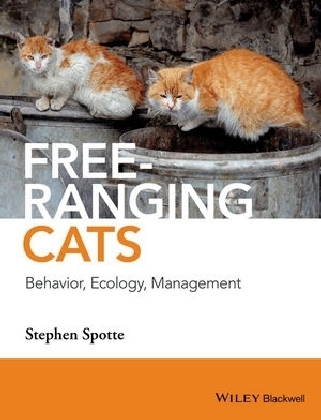
Free-ranging Cats
Wiley-Blackwell (Verlag)
978-1-118-88401-0 (ISBN)
Feral and stray domestic cats occupy many different habitats. They can resist dehydration for months by relying exclusively on the tissue water of their prey allowing them to colonize remote deserts and other inhospitable places. They thrive and reproduce in humid equatorial rainforests and windswept subantarctic islands. In many areas of the world feral cats have driven some species of birds and mammals to extinction and others to the edge, becoming a huge conservation concern. With the control of feral and stray cats now a top conservation priority, biologists are intensifying efforts to understand cat behaviour, reproductive biology, use of space, intraspecies interaction, dietary requirements, prey preferences, and vulnerability to different management strategies.
This book provides the most comprehensive review yet published on the behavior, ecology and management of free-ranging domestic cats, whether they be owned, stray, or feral. It reviews management methods and their progress, and questions several widely accepted views of free-ranging cats, notably that they live within dominance hierarchies and are highly social.
Insightful and objective, this book includes:
a functional approach, emphasizing sensory biology, reproductive physiology, nutrition, and space
partitioning;
clear treatment of how free-ranging cats should be managed;
extensive critical interpretation of the world's existing literature;
results of studies of cats in laboratories under controlled conditions, with data that can also be
applied to pet cats.
Free-ranging Cats: Behavior, Ecology, Management is valuable to ecologists, conservation scientists, animal behaviorists, wildlife nutritionists, wildlife biologists, research and wildlife veterinarians, clinical veterinarians, mammalogists, and park and game reserve planners and administrators.
Dr Stephen Spotte is a marine scientist and an adjunt scientist at Mote Marine Laboratory (Sarasota, Florida). He is an author or co-author of more than 80 scientific papers and has written 18 books.
Preface xi
Abbreviations and symbols xvii
About the companion website xix
1 Dominance 1
1.1 Introduction 1
1.2 Dominance defined 1
1.3 Dominance status and dominance hierarchies 6
1.4 Dominance–submissive behavior 10
1.5 Dominance in free-ranging cats 15
2 Space 19
2.1 Introduction 19
2.2 Space defined 20
2.3 Diel activity 23
2.4 Dispersal 26
2.5 Inbreeding avoidance 27
2.6 Home-range boundaries 31
2.7 Determinants of home-range size 33
2.8 Habitat selection 41
2.9 Scent-marking 43
3 Interaction 49
3.1 Introduction 49
3.2 The asocial domestic cat 49
3.3 Solitary or social? 52
3.4 Cooperative or not? 58
3.5 The kinship dilemma 61
3.6 What it takes to be social 66
4 Reproduction 72
4.1 Introduction 72
4.2 Female reproductive biology 72
4.3 Male reproductive biology 84
4.4 The cat mating system: promiscuity or polygyny? 88
4.5 Female mating behavior 91
4.6 Male mating behavior 93
4.7 Female choice 96
5 Development 98
5.1 Introduction 98
5.2 Intrauterine development 98
5.3 Dens 100
5.4 Parturition 100
5.5 Early maturation 104
5.6 Nursing 108
5.7 Weaning 109
5.8 Survival 111
5.9 Effect of early weaning and separation 113
5.10 Early predatory behavior 114
6 Emulative learning and play 116
6.1 Introduction 116
6.2 Emulative learning 116
6.3 Play 121
6.4 Ontogenesis of play 125
6.5 What is play? 130
7 Nutrition 137
7.1 Introduction 137
7.2 Proximate composition 138
7.3 Proteins 139
7.4 Fats 148
7.5 Carbohydrates 150
7.6 Fiber 155
7.7 Vitamins 156
8 Water balance and energy 158
8.1 Introduction 158
8.2 Water balance 158
8.3 Energy 162
8.4 Energy needs of free-ranging cats 166
8.5 Energy costs of pregnancy and lactation 172
8.6 Obesity 178
9 Foraging 181
9.1 Introduction 181
9.2 Cats as predators 182
9.3 Scavenging 185
9.4 When cats hunt 189
9.5 Food intake of feral cats 189
9.6 How cats detect prey 190
9.7 How cats hunt 200
9.8 What cats hunt 205
9.9 Prey selection 207
9.10 The motivation to hunt 210
10 Management 214
10.1 Introduction 214
10.2 Effect of free-ranging cats on wildlife 215
10.3 Trap–neuter–release (TNR) 224
10.4 Biological control 233
10.5 Poisoning and other eradication methods 237
10.6 Integrated control 241
10.7 Preparation for eradication programs 245
10.8 “Secondary” prey management 247
References 251
Index 293
| Verlagsort | Hoboken |
|---|---|
| Sprache | englisch |
| Maße | 198 x 254 mm |
| Gewicht | 862 g |
| Themenwelt | Naturwissenschaften ► Biologie ► Ökologie / Naturschutz |
| Naturwissenschaften ► Biologie ► Zoologie | |
| ISBN-10 | 1-118-88401-9 / 1118884019 |
| ISBN-13 | 978-1-118-88401-0 / 9781118884010 |
| Zustand | Neuware |
| Haben Sie eine Frage zum Produkt? |
aus dem Bereich


